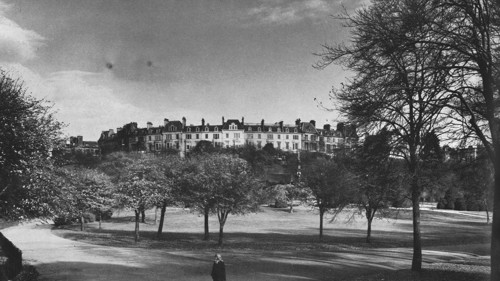Park District - Times Past

In partnership with the Glasgow Times, our archivists are exploring Glasgow's fascinating history. This week, Michael Gallagher writes about the Park District.
One of the many delights of working in the Mitchell Library is the ability to take a lunchtime stroll around what is now called the Park Conservation Area.
Beginning at North Street and the M8 motorway, the area’s unofficial boundary runs westward along the leafy terraces that flank Sauchiehall Street to the Kelvingrove Art Gallery and Museum. It then follows the curve of the River Kelvin northwards through the park and completes an eastwards loop along Woodlands Road and back towards the Mitchell.
Although the district clearly takes its modern name from Kelvingrove Park, development started many decades before. One of the first to build on the land was Dr James McNayr. Very much a man of letters, McNayr was an early owner of the Glasgow Herald newspaper and, in the late 18th century, built his home in the centre of the oval that would become Park Circus.
That the building was named Woodlands House gives some idea of the surrounding leafy landscape at the time, and the house was colloquially known as McNayr’s Folly due to its remoteness from the city.
The area would not stay remote for long, however. As the 19th century progressed, Glasgow’s wealthier denizens sought fresh air and space in the suburbs and the city expanded westwards. Development began on the eastern flank of the neighbourhood in the 1830s, firstly on the lower slopes of the hill around Woodside Crescent and Place. We think of the area as quintessentially Glaswegian, but it was designed by an Edinburgh architect, George Smith.
Over the next four decades the district came together gradually, not as a result of a single masterplan but through what one architectural critic called a fine example of “free urban planning”. Owners, developers and architects worked together to lay out the streets and buildings in a way that was not formally controlled yet retained a consistent feel.
The streets around Royal Crescent and Sandyford Place were next to be built as the development hugged the lower parts of Woodlands Hill. From there, it meandered up towards the crown of the hill and its most dramatic point in the Park Circus vicinity.
Charles Wilson was the man entrusted with designing the upper tiers. Wilson had studied architectural forms in Europe, and these French and Italian influences can be seen in both his general layout plan of grand, sweeping curves, and each building’s individual, ornate traits.
Wilson’s plan dovetailed with that of Sir Joseph Paxton, the leading landscaper of the period, who was commissioned by the Glasgow Corporation to design the new Kelvingrove Park (initially named West End Park) in 1854. By the 1870s the picturesque neighbourhood was complete and quickly became the go-to locale for Glasgow’s affluent merchants, industrialists and professional classes.
Today, the Park District remains an important part our architectural heritage and serves as a reminder of both the grand scale and vision of Victorian planning, and Glasgow’s goal to be the “Second City of the Empire”.
